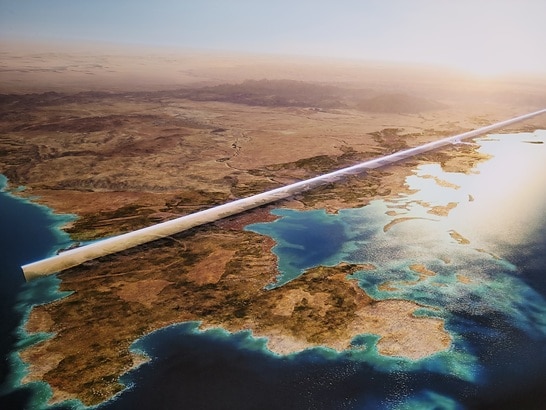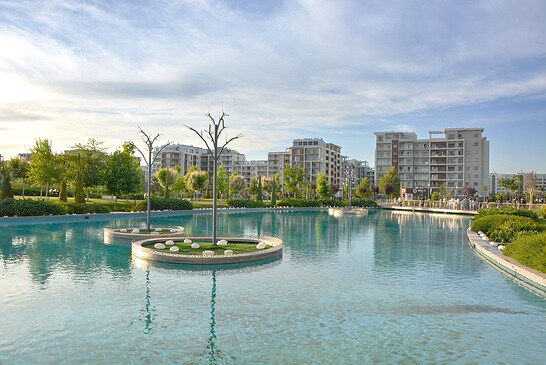PLANNED CITIES are not a modern invention. People have been building completely new cities on “green fields” for millennia. The goal has always been not only to create space, but to build the ideal city. Many cities that we now think of as having developed organically over time actually started out as planned cities, including New Delhi, Canberra, Berne, Islamabad and Washington D.C. Even today, new cities are being built all around the world. They are located in Africa or in Asia, in the desert or in the jungle, and are emerging from different cultures. They are underpinned by visionary concepts that, despite all their differences, share the same goal: smart, sustainable and high-quality environments for living and working. Wilo offers innovative products, solutions and systems that are being used in many of these metropolises of the future that are being created right now.

The presidential palace, which has been designed in the form of a Garuda – the mythological creature that is Indonesia’s national symbol – will stand on an area covering 55 hectares in the heart of Nusantara.
With around 30 million inhabitants, Indonesia’s current capital city Jakarta is one of the largest metropolises in the world. But climate change and overcrowding are choking the megacity. This is why the national government has decided to build a new capital: Nusantara.

NUSANTARA is an ancient Javanese word meaning “archipelago”. The name of the new capital is fitting for a country that stretches across more than 17,000 islands. The plans for Nusantara comprise a green metropolis that will rely on renewable energy, where the traffic infrastructure will not get clogged up and people will be able to stroll and cycle along grassy paths. Nusantara is set to be a model of urban planning for a sustainable city, as well as boosting the economic growth and transformation of the island nation. Construction work has already begun. Wilo and the Nusantara National Capital Authority have signed a memorandum of understanding that will pave the way for a collaboration. Wilo is also participating in numerous tenders forming part of the overall project. Once the construction work is complete, Indonesia’s new capital city, with the presidential palace modelled after the national symbol at its centre, will cover a good 2,500 square metres and be home to 2 million people.
One of the largest and most ambitious urban planning projects of all time is being developed in north-west Saudi Arabia: NEOM. A city of the future and a centre for technology and free trade is set to emerge on an area covering more than 26,000 square kilometres.

NEOM is designed as a megacity that will combine start-of-the-art technology, sustainable energy and water supply systems, innovative methods of food production, advanced manufacturing processes and digital services. The planned city is part of the Saudi “Vision 2030”, which aims to diversify the country’s economy and reduce its dependence on oil exports. The city is intended to provide an attractive location for international investments and act as a magnet for skilled employees and scientists from around the world. Comprising investments estimated to be worth USD 500 billion, NEOM is one of the biggest projects of its kind in the whole world. Moreover, the planners and designers are placing the focus on sustainability with the goal of running the city completely using renewable energy and developing a new model for urban living space in the 21st century. Wilo has already won numerous tenders in the overall project and will supply products, systems and solutions, from pressure boosting and irrigation to sewage disposal.
The idea behind the Tashkent New City urban planning initiative is to add around 230 square kilometres of smart and sustainable districts to the capital city of Uzbekistan. A special focus will be placed on green corridors, energy efficiency and future-proof traffic concepts.

IN MARCH 2023, the president of Uzbekistan, Shavkat Mirziyoyev, laid the foundation stone for the construction of Tashkent New City. It will cover around 6,000 hectares and serve as an addition to the existing capital. It is planned that a million people will live and work in the new city in the future. The project is intended to give the Uzbek economy a powerful and long-term boost to growth while also providing a blueprint for sustainable and green urban planning. A “trigeneration station” will generate especially efficient electricity along with heating in the winter and cooling in the summer. And the new city is also forging innovative paths in water management. The plan is to halve the city’s water consumption by using water-saving technologies. Wastewater will be thoroughly treated and reused for irrigation and other purposes. Wilo will manufacture made-to-measure products and systems for these applications that satisfy the highest demands for sustainability and efficiency. The Uzbek government and Wilo signed a memorandum of understanding on strategic cooperation in 2023.
To the north of the Kazakh metropolis Almaty and along the route to Konaev is Alatau, an emerging special economic zone. Around 2 million people are set to live and work here by 2048.

ALATAU was called “G4 City” in the planning stage. The four Gs stood for Gate, Golden, Growing and Green City – four structurally integrated, unique smart cities that are being developed north of Almaty. As a business and finance centre, the “Gate District” will be the gateway to the capital. The “Golden District” will include sports, health and education facilities. The “Growing District” is planned as a modern industrial zone. And the “Green District” will be a tourism and entertainment centre. Together, these new intelligent cities will offer the best possible conditions for strong economic growth and a high quality of life. The plans of the Kazakh government envisage that the four cities will be completed by 2048, by which time they will accommodate a population of around 2 million people. In addition, there are plans to upgrade the banks of Kapchagay Reservoir accompanied by the implementation of modern wastewater treatment projects. Wilo is involved in the Alatau projects, offering a variety of applications from drainage stations to building services.
EKO ATLANTIC CITY, NIGERIA
NEW CAIRO, EGYPT
Nestled within the vast metropolitan area of Cairo, New Cairo emerges as a solution to the urgent challenges posed by urban congestion and population growth. Formed in 2000 by merging three thriving cities, this satellite metropolis sprawls across an impressive 85,000 acres. Its strategic design aims to alleviate the population pressures burdening the densely populated capital of Cairo. Upon completion, the city is projected to accommodate an estimated four to five million residents. New Cairo harmoniously combines modernity and tradition, providing a promising haven for those aspiring to shape their future within Egypt's vibrant cultural tapestry.
NEW AMMAN CITY, JORDAN
Located approximately 40 kilometres east of the historic capital, New Amman City stands as a symbol of innovation and sustainability in the heart of Jordan. This project represents a bold endeavour to shape a new urban landscape, equipped with state-of-the-art infrastructure and services. Embracing the principles of intelligence and sustainability, the city aims to attract significant investments while fostering an environment conducive to growth and prosperity. Without the intention of overshadowing the capital, New Amman City emerges as a dynamic hub harnessing innovation through transformative public-private partnerships.
LUSAIL CITY, QATAR
Lusail City is the economic capital of Qatar and is located on the coast. Spanning over 38 square kilometres, this planned city is designed to accommodate a thriving population of 450,000 people. From luxurious residential enclaves to bustling commercial districts and world-class leisure facilities, Lusail City epitomises opulence and sophistication. Having hosted the 2022 FIFA World Cup Final, and boasting amenities such as a Formula One racetrack, Lusail City showcases Qatar's commitment to global innovation and progress.
CHENGDU FUTURE CITY, CHINA
Chengdu Future City in the Chinese province of Sichuan exemplifies a new approach to urban living. Spanning across 4.6 square kilometres, Chengdu Future City distinguishes itself from traditional cities. Drawing inspiration from the historic Linpan settlements, it embraces a unique approach. With a focus on education, innovation, and dynamic living, the city is divided into six distinct sections, each thoughtfully crafted to harmonise with the natural surroundings. The renowned architects OMA and GMP collaborated to create a car-free city, seamlessly integrating stunning architecture with the landscape. The result is a captivating fusion of buildings and landscape.
XIONG’AN, CHINA
The Xiong’an New Area is 100 kilometres southwest of Beijing. On the one hand, the urban development project in the Chinese province of Hebei aims to relieve the Chinese capital and reduce congestion and pollution there.
On the other hand, Xiong’an is also an experimental laboratory and a model for the development of the city in China in general. The Xiong’an New Area is considered a key component of China’s efforts to promote sustainable urbanisation and balanced regional development. It is designed as a green and smart city with a focus on innovation, environmental protection and high-quality development. The area is to become a centre for artificial intelligence, high-tech industries and modern services.
By 2035, around 2.5 million people are expected to settle in this 2,000 square kilometre area, about twice the size of New York City. The city will be fully powered by renewable energy.
SONGDO CITY, SOUTH KOREA
Located on reclaimed land near Incheon, Songdo International Business District (IBD) exemplifies South Korea's strong dedication to sustainability and innovation. Renowned for its smart design and eco-conscious ethos, Songdo offers lush green areas, efficient transportation systems, and state-of-the-art technology infrastructure. Whether it is hosting international organisations or providing a nurturing community for its residents, the city prioritises environmental consciousness and a high quality of life. Hence, distinguishing itself as a trailblazing urban development. Songdo reimagines the concept of modern urban living.